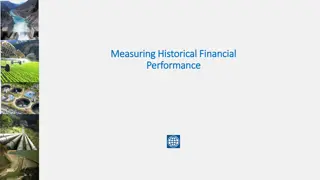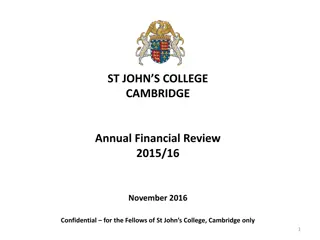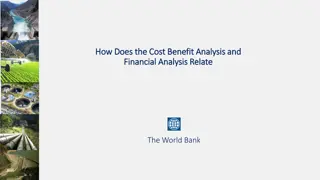Understanding Financial Statement Analysis: Framework, Examples, and Types
Dive into the world of financial statement analysis with a focus on its framework, external and internal uses, and primary types of financial statements. Explore how businesses assess their financial health through ratio analysis, trend analysis, and common-size analysis to make informed decisions for sustainable growth.
Download Presentation

Please find below an Image/Link to download the presentation.
The content on the website is provided AS IS for your information and personal use only. It may not be sold, licensed, or shared on other websites without obtaining consent from the author. Download presentation by click this link. If you encounter any issues during the download, it is possible that the publisher has removed the file from their server.
E N D
Presentation Transcript
Chapter 6 Financial Statement Analysis 6-1
Financial Statement Analysis Financial Statements A Possible Framework for Analysis Ratio Analysis Trend Analysis Common-Size and Index Analysis 6-2
Examples of External Uses of Statement Analysis Trade Creditors -- Focus on the liquidity of the firm. Bondholders -- Focus on the long-term cash flow of the firm. Shareholders -- Focus on the profitability and long-term health of the firm. 6-3
Examples of Internal Uses of Statement Analysis Plan -- Focus on assessing the current financial position and evaluating potential firm opportunities. Control -- Focus on return on investment for various assets and asset efficiency. Understand -- Focus on understanding how suppliers of funds analyze the firm. 6-4
Primary Types of Financial Statements Balance Sheet A summary of a firm s financial position on a given date that shows total assets = total liabilities + owners equity. Income Statement A summary of a firm s revenues and expenses over a specified period, ending with net income or loss for the period. 6-5
Basket Wonders Balance Sheet (Asset Side) Basket Wonders Balance Sheet (thousands) Dec. 31, 2003a a. How the firm stands on a specific date. b. What BW owned. c. Amounts owed by customers. d. Future expense items already paid. e. Cash/likely convertible to cash within 1 year. f. Original amount paid. g. Acc. deductions for wear and tear. Cash and C.E. Acct. Rec.c Inventories Prepaid Exp d Accum Tax Prepay Current Assetse $1,195 Fixed Assets (@Cost)f 1030 Less: Acc. Depr. g (329) Net Fix. Assets$ 701 Investment, LT Other Assets, LT Total Assets b $2,169 $ 90 10 394 696 5 50 223 6-6
Basket Wonders Balance Sheet (Liability Side) Basket Wonders Balance Sheet (thousands) Dec. 31, 2003 a. Note, Assets = Liabilities + Equity. b. What BW owed and ownership position. c. Owed to suppliers for goods and services. d. Unpaid wages, salaries, etc. e. Debts payable < 1 year. f. Debts payable > 1 year. g. Original investment. h. Earnings reinvested. Notes Payable Acct. Payablec Accrued Taxes d Other Accrued Liab. d Current Liab. e $ 500 Long-Term Debt f Shareholders Equity Com. Stock ($1 par) g Add Pd in Capital g Retained Earnings h Total Equity $1,139 Total Liab/Equitya,b $2,169 $ 290 94 16 100 530 200 729 210 6-7
Basket Wonders Income Statement Basket Wonders Statement of Earnings (in thousands) for Year Ending December 31, 2003a a. Measures profitability over a time period. b. Received, or receivable, from customers. c. Sales comm., adv., officers salaries, etc. d. Operating income. e. Cost of borrowed funds. f. Taxable income. g. Amount earned for shareholders. Net Sales Cost of Goods Soldb 1,599 Gross Profit $ 612 SG&A Expenses c 402 EBITd $ 210 Interest Expensee EBT f Income Taxes EATg Cash Dividends Increase in RE $ 53 $ 2,211 59 $ 151 60 $ 91 38 6-8
Framework for Financial Analysis Trend / Seasonal Component How much funding will be required in the future? Is there a seasonal component? 1. Analysis of the funds needs of the firm. Analytical Tools Used Sources and Uses Statement Statement of Cash Flows Cash Budgets 6-9
Framework for Financial Analysis Health of a Firm 1. Analysis of the funds needs of the firm. Financial Ratios 2. Analysis of the financial condition and profitability of the firm. 1. Individually 2. Over time 3. In combination 4. In comparison 6-10
Framework for Financial Analysis Business risk relates to the risk inherent in the operations of the firm. 1. Analysis of the funds needs of the firm. Examples: Volatility in sales Volatility in costs 2. Analysis of the financial condition and profitability of the firm. 3. Analysis of the business risk of the firm. Proximity to break-even point 6-11
Framework for Financial Analysis A Financial Manager must consider all three jointly when determining the financing needs of the firm. 1. Analysis of the funds needs of the firm. Determining the financing needs of the firm. 2. Analysis of the financial condition and profitability of the firm. 3. Analysis of the business risk of the firm. 6-12
Framework for Financial Analysis 1. Analysis of the funds needs of the firm. Determining the financing needs of the firm. Negotiations with suppliers of capital. 2. Analysis of the financial condition and profitability of the firm. 3. Analysis of the business risk of the firm. 6-13
Use of Financial Ratios Types of Comparisons A Financial Ratio is an index that relates two accounting numbers and is obtained by dividing one number by the other. Internal Comparisons External Comparisons 6-14
External Comparisons and Sources of Industry Ratios Examples: Robert Morris Associates Dun & Bradstreet Almanac of Business and Industrial Financial Ratios This involves comparing the ratios of one firm with those of similar firms or with industry averages. Similarity is important as one should compare apples to apples. 6-15
Liquidity Ratios Current Balance Sheet Ratios Current Assets Current Liabilities Liquidity Ratios For Basket Wonders December 31, 2003 Shows a firm s ability to cover its current liabilities with its current assets. $1,195 $500 = 2.39 6-16
Liquidity Ratio Comparisons Current Ratio BW 2.39 2.26 1.91 Industry 2.15 2.09 2.01 Year 2003 2002 2001 Ratio is stronger than the industry average. 6-17
Liquidity Ratios Acid-Test (Quick) Balance Sheet Ratios Current Assets - Inv Current Liabilities Liquidity Ratios For Basket Wonders December 31, 2003 Shows a firm s ability to meet current liabilities with its most liquid assets. $1,195 - $696 $500 = 1.00 6-18
Liquidity Ratio Comparisons Acid-Test Ratio BW 1.00 1.04 1.11 Industry 1.25 1.23 1.25 Year 2003 2002 2001 Ratio is weaker than the industry average. 6-19
Summary of the Liquidity Ratio Comparisons Ratio Current Acid-Test 1.00 BW 2.39 Industry 2.15 1.25 Strong current ratio and weak acid-test ratio indicates a potential problem in the inventories account. Note that this industry has a relatively high level of inventories. 6-20
Current Ratio -- Trend Analysis Comparison Trend Analysis of Current Ratio 2.5 2.3 Ratio Value 2.1 BW Industry 1.9 1.7 1.5 2001 2002 2003 Analysis Year 6-21
Acid-Test Ratio -- Trend Analysis Comparison Trend Analysis of Acid-Test Ratio 1.5 1.3 Ratio Value BW Industry 1.0 0.8 0.5 2001 2002 2003 Analysis Year 6-22
Summary of the Liquidity Trend Analyses The current ratio for BW has been rising at the same time the acid-test ratio has been declining. The current ratio for the industry has been rising slowly at the same time the acid-test ratio has been relatively stable. This indicates that inventories are a significant problem for BW. 6-23
Financial Leverage Ratios Debt-to-Equity Balance Sheet Ratios Total Debt Financial Leverage Ratios Shareholders Equity For Basket Wonders December 31, 2003 Shows the extent to which the firm is financed by debt. $1,030 $1,139 = .90 6-24
Financial Leverage Ratio Comparisons Debt-to-Equity Ratio BW .90 .88 .81 Industry .90 .90 .89 Year 2003 2002 2001 BW has average debt utilization relative to the industry average. 6-25
Financial Leverage Ratios Debt-to-Total-Assets Balance Sheet Ratios Total Debt Total Assets Financial Leverage Ratios For Basket Wonders December 31, 2003 Shows the percentage of the firm s assets that are supported by debt financing. $1,030 $2,169 = .47 6-26
Financial Leverage Ratio Comparisons Debt-to-Total-Asset Ratio BW .47 .47 .45 Industry .47 .47 .47 Year 2003 2002 2001 BW has average debt utilization relative to the industry average. 6-27
Financial Leverage Ratios Total Capitalization (i.e., LT-Debt + Equity) Balance Sheet Ratios Total Debt Total Capitalization Financial Leverage Ratios For Basket Wonders December 31, 2003 $1,030 $1,669 Shows the relative importance of long-term debt to the long-term financing of the firm. = .62 6-28
Financial Leverage Ratio Comparisons Total Capitalization Ratio BW .62 .62 .67 Industry .60 .61 .62 Year 2003 2002 2001 BW has average long-term debt utilization relative to the industry average. 6-29
Coverage Ratios Interest Coverage Income Statement Ratios EBIT Interest Charges Coverage Ratios For Basket Wonders December 31, 2003 Indicates a firm s ability to cover interest charges. $210 $59 = 3.56 6-30
Coverage Ratio Comparisons Interest Coverage Ratio BW 3.56 4.35 10.30 Industry 5.19 5.02 4.66 Year 2003 2002 2001 BW has below average interest coverage relative to the industry average. 6-31
Coverage Ratio -- Trend Analysis Comparison Trend Analysis of Interest Coverage Ratio 11.0 9.0 Ratio Value 7.0 BW Industry 5.0 3.0 2001 2002 2003 Analysis Year 6-32
Summary of the Coverage Trend Analysis The interest coverage ratio for BW has been falling since 2001. It has been below industry averages for the past two years. This indicates that low earnings (EBIT) may be a potential problem for BW. Note, we know that debt levels are in line with the industry averages. 6-33
Activity Ratios Receivable Turnover (Assume all sales are credit sales.) Income Statement / Balance Sheet Ratios Annual Net Credit Sales Receivables Activity Ratios For Basket Wonders December 31, 2003 Indicates quality of receivables and how successful the firm is in its collections. $2,211 $394 = 5.61 6-34
Activity Ratios Avg Collection Period Income Statement / Balance Sheet Ratios Days in the Year Receivable Turnover For Basket Wonders December 31, 2003 Activity Ratios Average number of days that receivables are outstanding. (or RT in days) 365 5.61 = 65 days 6-35
Activity Ratio Comparisons Average Collection Period BW 65.0 71.1 83.6 Industry 65.7 66.3 69.2 Year 2003 2002 2001 BW has improved the average collection period to that of the industry average. 6-36
Activity Ratios Payable Turnover (PT) (Assume annual credit purchases = $1,551.) Income Statement / Balance Sheet Ratios Annual Credit Purchases Accounts Payable Activity Ratios For Basket Wonders December 31, 2003 $1551 $94 Indicates the promptness of payment to suppliers by the firm. = 16.5 6-37
Activity Ratios PT in Days Income Statement / Balance Sheet Ratios Days in the Year Payable Turnover Activity Ratios For Basket Wonders December 31, 2003 Average number of days that payables are outstanding. 365 16.5 = 22.1 days 6-38
Activity Ratio Comparisons Payable Turnover in Days BW 22.1 25.4 43.5 Industry 46.7 51.1 48.5 Year 2003 2002 2001 BW has improved the PT in Days. Is this good? 6-39
Activity Ratios Inventory Turnover Income Statement / Balance Sheet Ratios Cost of Goods Sold Inventory Activity Ratios For Basket Wonders December 31, 2003 Indicates the effectiveness of the inventory management practices of the firm. $1,599 $696 = 2.30 6-40
Activity Ratio Comparisons Inventory Turnover Ratio BW 2.30 2.44 2.64 Industry 3.45 3.76 3.69 Year 2003 2002 2001 BW has a very poor inventory turnover ratio. 6-41
Inventory Turnover Ratio -- Trend Analysis Comparison Trend Analysis of Inventory Turnover Ratio 4.0 3.5 Ratio Value 3.0 BW Industry 2.5 2.0 2001 2002 2003 Analysis Year 6-42
Activity Ratios Total Asset Turnover Income Statement / Balance Sheet Ratios Net Sales Total Assets Activity Ratios For Basket Wonders December 31, 2003 Indicates the overall effectiveness of the firm in utilizing its assets to generate sales. $2,211 $2,169 = 1.02 6-43
Activity Ratio Comparisons Total Asset Turnover Ratio BW 1.02 1.03 1.01 Industry 1.17 1.14 1.13 Year 2003 2002 2001 BW has a weak total asset turnover ratio. Why is this ratio considered weak? 6-44
Profitability Ratios Gross Profit Margin Income Statement / Balance Sheet Ratios Gross Profit Net Sales Profitability Ratios For Basket Wonders December 31, 2003 Indicates the efficiency of operations and firm pricing policies. $612 $2,211 = .277 6-45
Profitability Ratio Comparisons Gross Profit Margin BW 27.7% 28.7 31.3 Industry 31.1% 30.8 27.6 Year 2003 2002 2001 BW has a weak Gross Profit Margin. 6-46
Gross Profit Margin -- Trend Analysis Comparison Trend Analysis of Gross Profit Margin 35.0 Ratio Value (%) 32.5 30.0 BW Industry 27.5 25.0 2001 2002 2003 Analysis Year 6-47
Profitability Ratios Net Profit Margin Income Statement / Balance Sheet Ratios Net Profit after Taxes Net Sales Profitability Ratios For Basket Wonders December 31, 2003 Indicates the firm s profitability after taking account of all expenses and income taxes. $91 $2,211 = .041 6-48
Profitability Ratio Comparisons Net Profit Margin BW 4.1% 4.9 9.0 Industry 8.2% 8.1 7.6 Year 2003 2002 2001 BW has a poor Net Profit Margin. 6-49
Net Profit Margin -- Trend Analysis Comparison Trend Analysis of Net Profit Margin 10 9 Ratio Value (%) 8 7 BW Industry 6 5 4 2001 2002 2003 Analysis Year 6-50























